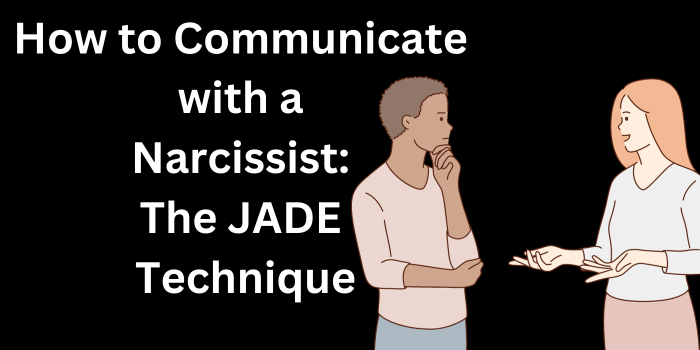Communicating with a narcissist can be a challenging and often emotionally draining experience. Narcissists tend to be self-absorbed, lack empathy, and have a strong need for admiration. They can be manipulative, defensive, and resistant to feedback, making it difficult to engage in productive conversations with them.
However, the JADE technique (Justify, Argue, Defend, Explain) can be a valuable tool for navigating interactions with narcissists and achieving more positive outcomes. In this blog post, we will delve into the JADE technique, explaining its principles and providing real-life examples to illustrate its effectiveness.
Understanding Narcissism
Before delving into the JADE technique, it’s essential to have a solid grasp of narcissism. Narcissistic Personality Disorder (NPD) is a complex condition characterized by a pervasive pattern of grandiosity, a constant need for admiration, and a lack of empathy for others.
While not everyone with narcissistic traits meets the clinical criteria for NPD, many exhibit these characteristics, making communication with them particularly challenging.
Key narcissistic traits include:
- Grandiosity: Narcissists often have an inflated sense of self-importance and believe they are superior to others.
- Need for Admiration: They crave constant admiration and validation, becoming agitated when they don’t receive it.
- Lack of Empathy: Narcissists struggle to understand or care about the feelings and needs of others.
- Manipulative Behavior: They may employ manipulation, guilt-tripping, and other tactics to achieve their goals.
- Defensiveness: Narcissists can become defensive and hostile when confronted or criticized.
Given these traits, it’s evident why communicating with a narcissist can be a formidable task. However, the JADE technique can be a valuable tool for navigating these conversations more effectively.
The JADE Technique: Justify, Argue, Defend, Explain
The JADE technique is an acronym representing four key principles:
- Justify: Provide a brief and concise justification for your thoughts, feelings, or actions without getting lost in excessive details or defenses.
- Argue: Avoid engaging in arguments or debates with the narcissist, as this often escalates conflicts.
- Defend: Refrain from becoming overly defensive or reactive during the conversation.
- Explain: Offer a simple and straightforward explanation for your perspective.
The core of the JADE technique is maintaining a calm and assertive demeanor while setting boundaries and expressing your thoughts and feelings clearly. Now, let’s explore each component of the JADE technique with real-life examples to illustrate its effectiveness.
1. Justify
When justifying your thoughts, feelings, or actions to a narcissist, keep it brief and focused on your perspective. Over-explaining or defending yourself excessively can lead to unnecessary conflicts. Here’s an example:
Example 1:
Narcissist: “You never support me in anything I do!”
You: “I have my own commitments and responsibilities, and sometimes I need to prioritize them.”
In this example, you provide a concise justification for your actions without getting caught in a lengthy argument.
2. Argue
Arguing with a narcissist can be counterproductive since they often thrive on conflict and may not be open to changing their viewpoint. Instead of engaging in an argument, it’s more helpful to assert your perspective calmly. Here’s an example:
Example 2:
Narcissist: “You’re always criticizing me!”
You: “I’m sharing my perspective, but I’m not trying to criticize you. I’d like us to have a constructive conversation.”
By not getting drawn into an argument, you maintain a more productive tone in the conversation.
3. Defend
When a narcissist attacks or criticizes you, it’s natural to want to defend yourself. However, getting overly defensive can escalate the conflict. Instead, respond assertively while setting boundaries. Here’s an example:
Example 3:
Narcissist: “You’re just saying that because you’re jealous of my success!”
You: “I’m not jealous; I’m happy for your success. Let’s discuss this without making assumptions about each other.”
In this example, you defend your position without becoming overly defensive or attacking back.
4. Explain
Explaining your perspective is an essential part of the JADE technique. However, keep your explanations clear and concise to avoid getting bogged down in unnecessary details. A straightforward explanation can help the narcissist better understand your viewpoint.
Example 4:
Narcissist: “Why do you always need so much time alone?”
You: “I value alone time to recharge and reflect. It helps me be more present when we’re together.”
By explaining your need for alone time in a straightforward manner, you provide insight into your perspective.
Tips for Effective Communication with Narcissists
While the JADE technique can be a valuable tool for communicating with narcissists, there are additional tips that can enhance your effectiveness in these interactions:
- Choose the Right Time: Timing is crucial. Pick a time when both you and the narcissist are calm and not in the midst of a conflict.
- Stay Calm and Patient: Narcissists may try to provoke emotional reactions. Stay composed and patient, maintaining your boundaries.
- Use “I” Statements: Express your feelings and needs using “I” statements, which can make your communication less accusatory and more about your experiences.
- Set Boundaries: Clearly communicate your boundaries and stick to them. Narcissists may test your limits, so consistency is key.
- Practice Active Listening: Try to understand the narcissist’s perspective, even if you disagree. This can show that you respect their viewpoint.
- Consider Seeking Professional Help: If communication remains consistently challenging or escalates into emotional abuse, consider seeking the help of a therapist or counselor.
Conclusion
Communicating with a narcissist can be challenging, but it is possible to navigate these interactions effectively using the JADE technique. By Justifying, Avoiding Arguments, Defending without defensiveness, and Explaining your perspective clearly and assertively, you can foster more productive conversations with narcissists.
Remember to remain calm, set boundaries, and prioritize self-care when dealing with challenging individuals. Ultimately, effective communication with narcissists requires patience, practice, and a commitment to maintaining your own emotional well-being.
I recommend to watch the Ellen Biros (LCSW) guide on YouTube , how to use this technique effectively.
